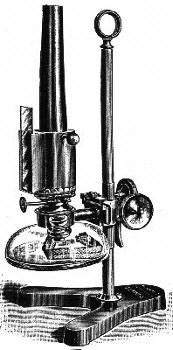 |
Fig.
1 left Oil lamp Note
microscope slide used as a lamp glass. Fig. 2 right |
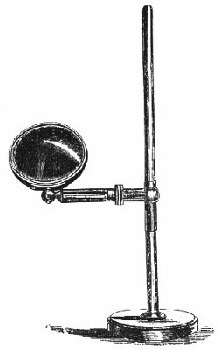 |
Incident Lighting and the Lieberkühn Speculum
by William Ells
Coniferae, Walnut Tree Lane, Loose, Maidstone, Kent, ME15 9RG,
UK.
Having read the article by Dave Walker in the latest paper copy of Micscape on the subject of top lighting or incident lighting, it reminded me of how the old time microscopist (even older than me) burnt the midnight oil quite literally before electricity was available to them and the electric torch had not been invented. In its stead, for what they described as opaque illumination, an oil lamp designed for use with the microscope Fig.1 (below), would be placed near the microscope, above the level of the stage, and the flame would be focused onto the object to be examined by means of a plano-convex lens known as a bulls-eye Fig.2 (below). This could be on a stand as shown or fixed to the microscope. That the old bulls-eye lens could be used in this way with modern electric lighting was demonstrated by Barry Ellam at a meeting of the Reading Microscopical Society.
 |
Fig.
1 left Oil lamp Note
microscope slide used as a lamp glass. Fig. 2 right |
 |
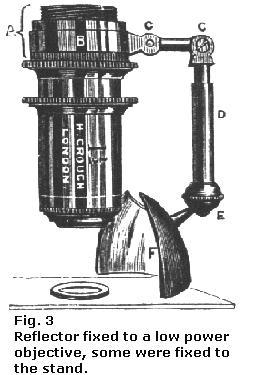 A reflector, usually of
polished metal known as a speculum, could be used to reflect the
beam from the oil lamp down onto the object Fig.3 right. The
speculum known as a Lieberkühn after its inventor;
J.N.Lieberkühn 1711 - 1756; was used in a different way and was
said to illuminate an opaque object much better. A Lieberkühn is
rather like the reflector from a small torch with the bulb
removed and fitted onto an objective. The beam of light is
reflected upwards by the mirror below the stage in the usual way,
the beam passes around the opaque object which must be small
enough to allow it to do so, the beam is then reflected down onto
the object by the speculum. The speculum must be so designed as
to focus the light beam onto the object when the objective is in
focus, thus each objective has to have its own speculum. Only
objectives with sufficient working distance to accomodate the
speculum can be used. See sketch Fig.4 below.
A reflector, usually of
polished metal known as a speculum, could be used to reflect the
beam from the oil lamp down onto the object Fig.3 right. The
speculum known as a Lieberkühn after its inventor;
J.N.Lieberkühn 1711 - 1756; was used in a different way and was
said to illuminate an opaque object much better. A Lieberkühn is
rather like the reflector from a small torch with the bulb
removed and fitted onto an objective. The beam of light is
reflected upwards by the mirror below the stage in the usual way,
the beam passes around the opaque object which must be small
enough to allow it to do so, the beam is then reflected down onto
the object by the speculum. The speculum must be so designed as
to focus the light beam onto the object when the objective is in
focus, thus each objective has to have its own speculum. Only
objectives with sufficient working distance to accomodate the
speculum can be used. See sketch Fig.4 below.
| Fig.
4 Sketch of Lieberkühn Blue; light source to the speculum is then reflected onto the object (red). Yellow; light reflected from object through the objective to the eyepiece. |
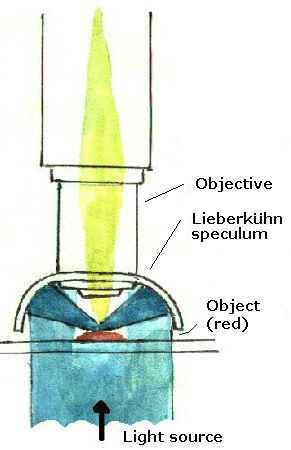 |
(Figures 1, 2 and 3 above are from the Microscope and its Revelations 7th Edition 1891. By W.B. Carpenter revised by W.H. Dallinger).
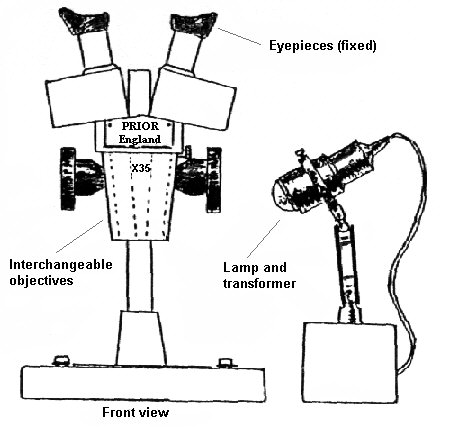
The Stereoscopic microscope Fig.5 right, and the modern type of incident lighting mentioned by Dave made the Lieberkühn obsolete.
Fig. 5
right.
Prior stereoscopic microscope
| Fig.
6 Simplified diagram of vertical light system Blue shows light beam reflected down by the clear glass at an angle of 45° through objective onto the object. Yellow light beam shows light reflected from the object through the objective up to the eyepiece. |
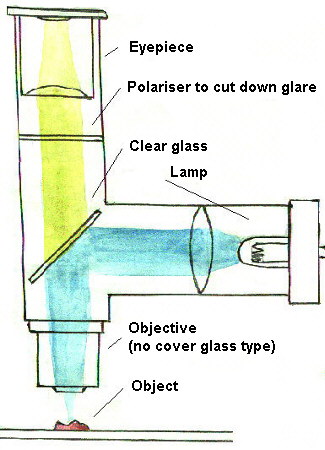 |
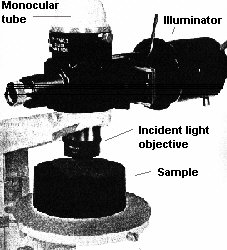 The drawing
Fig.6 above gives some idea of how the modern method works. An
adapter for a similar type of incident lighting is supplied for
the Russian Biolam as used by Dave is shown in Fig. 7 right.
The drawing
Fig.6 above gives some idea of how the modern method works. An
adapter for a similar type of incident lighting is supplied for
the Russian Biolam as used by Dave is shown in Fig. 7 right.
If I remember rightly, Tony Dutton demonstrated a microscope adapted for this method of incident lighting using equipment he has constructed, at meetings of the Quekett Microscopical Club in London. A good description showing the light path for; darkfield; polarisation ; and differential contrast using reflected light as well as the method shown in Fig. 6. is in 'Microscopy from the Very Beginning' (1994) pages 27 & 28, published by Carl Zeiss. Top lighting, incident, opaque, reflected and vertical illumination are all names used to described this form of lighting.
Some years ago on a visit to the Jodrell Laboratory at Kew Gardens a transverse section of a twig of charcoal was shown on a incident light microscope, this made a stunning image. I cannot remember any details, what wood was used, whether the charcoal was fractured or cut, it is something you might like to experiment with.
I sent Mr. Barry Ellam a draught copy of the above article, and he kindly provided further information, part of which is shown below.
'Lieberkühn was an anatomist discoverer of the 'crypts of Lieberkühn' in the intestines. The peculiar beauty of the Lieberkühn speculum was that it illuminated the object from every aspect. This meant that in comparison with the silver side reflector there was a loss of relief. This could be corrected by covering part of the speculum.
As to the bullseye. This is a useful accessory not always appreciated. I believe it was an author called Braun who in 'Science Gossip' in the 1870's described a technique for using the bullseye for top lighting. The sketch below (Fig. 8) will I hope be self-explanatory. The sketch also shows the use of a 'Darle well' this is a small hollow blackened cylinder with a rod beneath which fitted a special holder in the substage (Fig. 9). This provides better black background than paper or card.'
| Figure
8. Diagram showing the use of the bullseye and 'Darle well' |
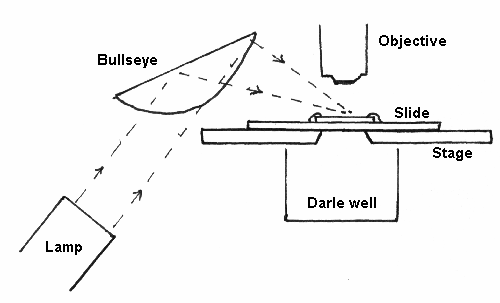 |
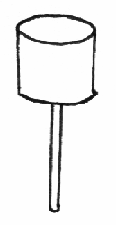 |
Figure 9. The 'Darle well' |
(I am going to try and make a 'Darle well' by cutting down a black container that 35mm films are supplied in. W.E.)
Comments and feedback to Bill Ells are welcomed.
Published in September 1998 Micscape Magazine.
Please report any Web problems
or offer general comments to the Micscape Editor,
via the contact on current Micscape Index.
Micscape is the on-line monthly
magazine of the Microscopy UK web
site at Microscopy-UK